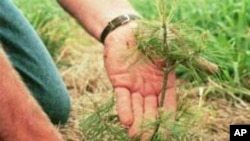A forestation technique developed by the United States Department of Agriculture Forest Service’s Center for Bottomland Hardwoods Research, in Stoneville, Mississippi, is helping to reduce carbon emissions through the planting of millions of trees in the South and Midwest. Using their cottonwood-hardwood interplanting method, center scientists are supporting the efforts of conservation capitalism company C2I and its partners to grow forests on underused farmland in Arkansas, Illinois, Kentucky, Louisiana, Mississippi, Missouri and Tennessee.
More than 3 million new mixed hardwood tree species have already been planted in Arkansas, Louisiana, and Mississippi. Another 6 million trees are scheduled to be planted on tens of thousands of hectares over the next five years in Mississippi and Louisiana. About 670 hardwoods and 670 cottonwoods will be planted per hectare. The long-term plan for the project, called GreenTrees, builds on increments of 15-year leases with participating landowners. The length of the leases increases the environmental benefits of the project, by protecting collected carbon for 40 years.
"This partnership combines resources that will create wildlife habitat, produce wood for paper and lumber, and remove carbon from the air for decades," said Ted Leininger, Project Leader for the Center for Bottomland Hardwoods Research. "It is so rewarding when the research of our dedicated scientists produces outcomes that benefit the environment and the economy. Successes like this inspire us to work harder to find more solutions to America’s natural resource problems."
In 1994, the research center scientists began testing different methods that would allow farmers to efficiently turn their underused land into valuable woodlands that would revitalize soil, generate revenue and collect carbon. The planting method adopted by GreenTrees uses cottonwood trees as trainers for hardwood seedlings. Also known as poplars, cottonwood trees grow from 20 to 30 meters tall, about 3 meters per year, and adapt to various soils and climates. Once established, the cottonwoods provide a forest environment that promotes the growth of straight-stemmed hardwoods, which grow much slower than cottonwoods.
Under the GreenTrees agreements, landowners retain their land and can bring in additional revenue through recreational usage, conservation tax benefits, and regulated timber sales through the USDA Conservation Reserve Program. The voluntary program provides agricultural landowners annual rental payments and cost-share assistance to establish long-term, resource-conserving covers on eligible farmland.
Growing levels of carbon emissions worldwide contribute to climate change and present a number of environmental challenges. The United States is committed to doing its part to reduce carbon emissions and protect the environment that all living creatures share.
More than 3 million new mixed hardwood tree species have already been planted in Arkansas, Louisiana, and Mississippi.


















